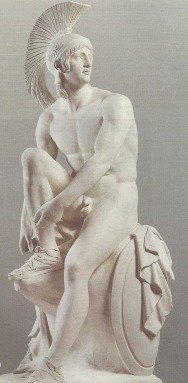Theseus, the legendary king of Athens
Befitting Athens, a city renowned for its thinkers, Theseus, the chief hero of Athenian legends, was known more for his quick wits than his strength. His cleverness made him - along with heroes such as Hercules, Perseus and Odysseus - one of the great monster slayers of greek mythology. The hero earned a reputation not only for his daring and intelligence, but also for his fairness. An early king of Athens, he was one of the first rulers to reform the government in the direction of democracy. As both a king and an adventurer, he defended the oppressed and consistently fought for the ideal of justice.
The adventurous journey to Athens Early Youth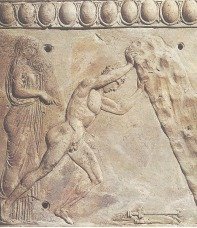 King Aegeus of Athens had long wanted a child, but his efforts in two marriages had proved fruitless. He at last decided to consult the oracle at Delphi, where he received a cryptic instruction: "Do not unloose the foot of your wineskin until you return to Athens". The king was puzzled by this, failing to decipher the meaning. Instead of returning directly to Athens, Aegeus headed for the small town of Troezen in Argolis. Aegeus hoped that his friend Pittheus - the king of Troezen - would help him solve the riddle of the oracle. Although the latter immediately interpreted the oracle - which of course had a sexual metaphorical meaning as you will see below - he did not share his interpretation with his friend, since he had other plans for him. That night, Pittheus got Aegeus drunk and led him to the bed of his daughter Aethra. Later that same night, Poseidon lay down with Aethra too - but neither Pittheus nor Aegeus knew of this coupling. The next morning, Aegeus buried his sword and his sandals under a massive rock near Troezen. He told Aethra that if she gave birth to his son and that boy grew strong enough to push aside the stone, she should send him with these items to Athens. In this way, Aegeus would recognize him as his son. Aethra did have a son and named him Theseus. The boy soon demonstrated both strength and cleverness. As a young wrestler, he is credited with transforming the sport of wrestling from a contest of brute strength into an art that blended fighting skills with agility and quick wits. At age sixteen, Theseus managed to move the stone, put on Aegeus's sandals and sword and set off for Athens. He ignored his grandfather's and mother's advice to sail across the Saronic Gulf. Instead, he chose to traverse the hazardous land route across the Isthmus of Corinthus. [top] The adventurous journey to Athens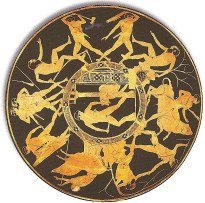 The hero encountered his first opponent near Epidaurus. This was the notorious Periphetes nicknamed Corynetes (meaning "Clubman"), son of the god Hephaestus, who killed travelers with a club (coryne). Theseus killed him and took his club as a trophy. A little further along the road, the hero came across Sinis, who was also known as Pityocamptes (meaning "Pine Bender"). Sinis would bend back two pines, then capture travelers and tie each of their legs to each tree. He would then let the pines snap back into place, thus tearing the traveler apart. Theseus beat Sinis and punished him with the same treatment he had reserved for strangers. While he was there, Theseus had his first erotic contact with Sinis's daughter, Perigune. A son, Melanippus, was born from their union. The hero had not gone much further when a ferocious sow rushed out at him. This wild pig had long ravaged the town of Crommyon. Named Phaea after the old woman who bred or owned her, the beast was yet another monstrous offspring of Typhon and Echidna. The hero used both sword and spear to kill the beast. Near Corinth, by a location now known as "Kakia Skala" (meaning "Evil Ladder"), Theseus encountered Sciron, also a son of Poseidon, who would force travelers to wash his feet. As they bent over, he would toss them over the cliff into the Saronic Gulf, where the poor victims would be devoured by a huge sea turtle. The hero agreed to wash Sciron's feet, but when he bent down, he managed to grab him by the ankles and hurl him down the cliff, thus becoming the last victim of the man eating turtle. Outside Eleusis, the hero fought and killed another son of Poseidon, Gercyon, who forced travelers to wrestle with him to death. Once again, he used wits, quickness and agility to defeat brute strength. At the end of the match, he lifted Gercyon up and smashed him to the ground, killing him instantly. The final monster encountered on the way to Athens, was named Procrustes. The father of Sinis the Pine Bender and son of Hephaestus, Procrustes would invite all weary travelers to rest at his home. But after his guests fell asleep, he would torture them:If their legs hung over the end of the bed, he would chop them off. If they were too short, he would attach weights to their arms and legs and would stretch them to size. As he had done with all the monsters he had encountered before, Theseus gave Procrustes a taste of his own medicine, by killing him the same way he used himself on his victims. Click here to see on a map, all the locations where the hero confronted his adversaries. [top] Arriving in AthensWhen the hero reached the outskirts of Athens, he offered a sacrifice to Zeus Meilichius and was purified of the killings he had committed on the way.Tales of his feats had already reached the palace of Aegeus, who at the time was living with Medea. Being a sorceress and having recognized the identity of the young hero, she talked the king into poisoning the young stranger, in an attempt to prevent Aegeus from recognizing his son so that her own son Medus, would be assured of accessing the throne. Aegeus thus invited Theseus to a symposium. During the meal, Theseus pulled out a knife to cut the meat. Aegeus immediately recognized it, as being the same one that he hid under the rock in Troezen, a long time ago. As soon as he realized that the young man he had before him was his son, he immediately poured out the tainted wine, officially recognized Theseus as his son and banished Medea and her son. After being declared the heir to the throne of Athens, Theseus faced and defeated his cousins, the sons of Pallas (Aegeus's brother), who had decided to kill the hero, as his sudden appearance had spoiled his plan to succeed his brother on the Athenian throne. He then captured the Marathon Bull, a wild beast which was ravaging the area around Athens. This bull was the same one captured by Hercules in Crete and brought to Tiryns in the course of his labors.
[top] The expedition to Crete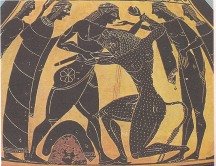 Athens, weakened by the plague, succumbed to Minos and Aegeus averted the invasion by agreeing to pay a terrible price. Every nine years, Minos came to Athens to collect his awful payment: Seven boys and seven virgin girls to be offered as food to the savage Minotaur. Now, the time came for the third tribute. The Minotaur, a monster with a bull's head and a man's body, was the offspring of Mino's wife, Pasiphae, and a handsome bull. At the beginning of Minos's reign, the king wanted to discourage any challenges to the throne by proving his divine right to rule Crete. He prayed to Poseidon to send him a sign, a bull which he promised to sacrifice. When the beast emerged from the sea, Minos admired it so much, that he substituted another one for the sacrifice. Poseidon, enraged, he avenged by making Pasiphae fall in love with the beast. Thus, the queen petitioned Daedalus, a brilliant inventor, to help her consummate her love. Daedalus constructed a hollow wooden cow and covered it with cow hides. The fake cow was so convincing, that it fooled the bull. Pasiphae, who was hidden inside the child, thus conceived a monstrous child, Minotaur. Daedalus then designed the labyrinth, a maze like prison in which the Minotaur lived. No one - except its builder Daedalus - had ever got into the maze and managed to get out. Despite his father's protests, Theseus volunteered to join the group to be sent to Crete for the sacrifice. His plan was to kill the beast and thus end the payment of the tribute to Crete. Concerned about his son, Aegeus made him promise that, on his return home he would signal his survival by replacing the black sails of the ship with white ones. When the shipload of Athenian sacrifices arrived in Crete, Ariadne - a daughter of Minos - fell in love with Theseus. She resolved to help him escape by giving him a spool of thread and a sword. When he entered the Labyrinth, he attached one end of the thread to the entrance. He then unraveled the ball as he explored the maze. Eventually, he found his way to the center of the maze, where he slew the mighty beast with the sword that Ariadne had given him. Afterwards, he wound the thread back to the ball, thus following its trail back to the entrance. The ship with the Athenians and Ariadne immediately set sail for Athens, thus escaping from Crete. They then made a stop at Naxos, a greek island. Myth tellers disagree on the final fate of Ariadne:
Neglecting to change the sails of his ship, Theseus sailed on to Athens. Aegeus, who was eager to learn about his son's fate, saw the black sails of the ship from afar while he was standing on a clip overlooking the sea. Assuming that his son was dead, he leaped from the cliff to his death. The sea that claimed his body was named thereafter the Aegean Sea, in honor of his name. [top] Adventure with the Amazons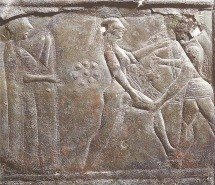 Being a king, however, did not discourage him from continuing his adventurous life. Some say he joined the Argonauts in their quest for the Golden Fleece. He also took part in the Calydon boar hunt. He also contributed significantly to the victory of Hercules over the Amazons, in the relevant labor. While he was with Hercules in the land of the Amazons, Antiope, one of the Amazon queens, fell in love with him. Betraying her sisters, she followed Theseus on his way back to Greece. The Amazons pursued the hero and Antiope to Athens, where they engaged in a fierce battle. Hippolyte, defeated, escaped to Megara, where she died. Antiope and Theseus had a son, Hippolytus. Storytellers disagree on the way she died:Some say she was killed by an Amazon warrior, while others say that she was accidentally killed by an Amazon ally of hers, Penthesilia, while they were battling against the other Amazons. Some even insist that Theseus himself killed her, when she attacked the guests at his wedding to Phaedra. [top] Phaedra and HippolytusTheseus was then married to Phaedra, who was Ariadne's sister. Out of wedlock, the king and queen had two sons: Acamas and Demophon. Theseus intended his sons to succeed him in ruling Athens, so he sent Hippolytus, his son from Antiope, to Troezen, where he would succeed the hero's grandfather, Pittheus.When Phaedra met once Hippolytus in Troezen, she fell in love with him. But the youth did not respond to her advances, because he was devoted to the goddess Artemis and was indifferent to women. Devastated, Phaedra killed herself, leaving a letter to Theseus, who was away on a trip, in which she claimed that Hippolytus raped her. Theseus refused to listen to his son's version of the story. Enraged, he called for his son's death by invoking one of the three curses that his father Poseidon had once bestowed upon him. As Hippolytus rode away along the coast in his chariot, a bull rose out of the sea and spooked the horses. The horses upset the chariot and dragged Hippolytus, who had become entangled in the reins, to his death. The goddess Artemis later appeared before Theseus, explaining to him the true version of the story. The real culprit behind the plot was the goddess Aphrodite, who wanted to punish Hippolytus for neglecting her and choosing Artemis over her. The tragic story of Phaedra and Hippolytus is the central theme of a drama by the ancient Greek playwright Euripides called "Hippolytus". His Roman counterpart Seneca also told a similar story in his "Phaedra". [top] The Abduction of HelenNot taken aback from the tragic end of his amorous adventures in the past (Ariadne, Antiope and Phaedra), Theseus was set on finding a suitable wife. His choice was princess Helen of Sparta, the same one who later sparked the Trojan War. At that time, Helen was in the age of 10-11, while Theseus was reaching fifty. As the myth goes, Helen was a daughter of Zeus and was the sister of the twins, Castor and Polydeuces.In this new adventure, he was assisted by his long time friend Peirithous, king of the Lapithae, a tribe who lived in Thessaly (northeastern Greece). Perithous first met Theseus when he tried to steal cattle from him, in an attempt to challenge the hero and see whether his fame for being a hero held to be true. When the two men met, they grew font of each other and became close friends. Peirithous was especially grateful to Theseus when he helped him battle against the Centaurs - half brothers of Peirithous since allegedly they all had Zeus as their father -, when, under the influence of alcohol, they created havoc at Peiritous's wedding with Hippodameia, at which they were invited as guests. In the ensuing war that broke out, Peirithous with the assistance of his friend Theseus managed to drive away all the Centaurs from Thessaly. After the two friend abducted Helen from Sparta, they left her with Theseus's mother Aethra in the town of Aphidnae and then set out to find and capture Perithous's choice of wife: Persephone, who at the time was residing in the Underworld with Hades. The two heroes joined to make the perilous journey to the Underworld. When they met Hades, he unexpectedly greeted them with hospitality and offered them to sit on stone chairs. To their amazement, their flesh became fastened to the chair and on top of this, they lost memory of their identity and what they were doing there altogether. To Theseus good fortune, he was released from his Chair of Forgetfulness, when Hercules visited Hades to accomplish his last labor, the capturing of Cerberus. However, Hercules was unable to free Peirithous, as he had to leave Hades in a hurry, due to an earthquake. Brought back to the living, Theseus found out that during his absence, the Dioscuri (Castor and Polydeuces, the twin brothers of Helen) had attacked Aphidnae, rescued their sister and abducted and enslaved Aethra. Athenians were furious with Theseus, holding him responsible for all the disasters that he brought upon them. By the time Theseus returned from the kingdom of death, they had ousted them as their king and put in his place Menestheus, who according to the historian Plutarch was a direct descendant of the great legendary Athenian king Erectheus. [top] The Shameful DeathUnable to win back the throne, Theseus took refuge in the Aegean island of Scyrus. There, king Lycomedes, perhaps fearing that his renowned visitor would take away the throne from him, drove the hero to his death, by pushing him over a steep cliff into the sea, while they were having a walk.Long after his death, the image of Theseus, fully armed, arose and helped Athenians to victory, during the battle of Marathon (490 BC). When the Persian Wars ended, the bones of the hero were restored to Athens for burial. They were placed in the city center at the Theseion, which became a refuge for the weak, for slaves and for all those oppressed by the powerful. The renowned king of Athens and the monster slayer hero was finally placed in the honorary position that he deserved, despite the foolish adventures that he forced his fellow citizens to endure during his reign.
Return from Theseus to Mythical Heroes |
|
|
Resource MaterialClassroom MaterialMovies,DVDs, Games and BooksAbout the SiteYour Stories |
||
|
|
||
